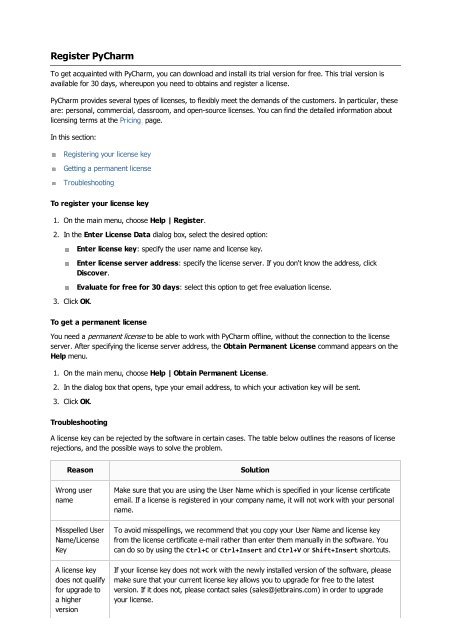- Python and Django IDE with refactorings, code completion, on-the-fly code analysis and coding productivity orientation.
- I have installed PyCharm Community 4 few weeks ago, and now I bought a student license (which is free of charge). I now want to install PyCharm Professional by deleting the Community version. Problem is I don't have a separate directory in which I extracted the PyCharm community. I somehow have managed to install it.
- Pycharm Download Community
- Pycharm Professional Or Community Difference
- Pycharm Community Licence Download
To open this dialog, do one of the following:

Community; PyCharm; License transfer Follow. Kimvais Created October 06, 2011 07:09. Hi, I recently bought a license for PyCharm but since I ordered a new laptop (which should arrive in shortly), I haven't entered the license in the PyCharm installation on my old laptop. Looks like the delivcery time of my laptop is slipping and the evaluation.
On the Welcome screen, click Configure | Manage License
From the main menu, select Help | Register

You can evaluate PyCharm Ultimate for 30 days. After that period, you need to buy PyCharm and activate your license.
Pycharm Download Community
The upper part of the dialog reflects your PyCharm usage status (for example Free evaluation) and, if appropriate, provides related controls (for example Buy PyCharm ).
The license activation options are in the lower part of the dialog under Activate new license via.
PyCharm usage status-related controls
| Item | Description |
|---|---|
| Buy PyCharm | Click this button to go to the JetBrains Web site to study the PyCharm purchasing options and to buy a license. |
| Evaluate for free for 30 days | Click this button to start evaluating PyCharm. |
License activation options
| Option | Description |
|---|---|
| JB Account | Register using the JetBrains Account. If you are using two-factor authentication for your JetBrains Account, specify the generated app password instead of the main JetBrains Account password. For more information, see What is JetBrains Account? |
| Activation code | Register using an activation code. You can get an activation code when you purchase a license for the corresponding product. |
| License server | Register using the Floating License Server. When performing silent install or managing PyCharm installations on multiple machines, you can set the Alternatively, you can set the Floating License Server URL by adding the |
If you encounter any issue when registering PyCharm, contact PyCharm support.
PyCharm and Jupyter are two very popular environments among Python developers and data scientists. Both these environments offer their own set of advantages. But which between the two should a data scientist pick?
Both PyCharm and Jupyter have their advantages in data science. Jupyter is more suitable as a prototyping tool for prototyping models and doing a quick analysis of data. PyCharm is generally suitable for building complex multi-layered applications that can analyze large data sets.
In this article, we will explore this subject in detail. We will start off by looking at the key features of each of these platforms. Next, we will differentiate between them and then finally discuss which of them is the better choice for data science.
PyCharm: Key Features
PyCharm is a Python IDE developed by JetBrains. It is one of the most popular Python IDEs among developers, and there are several reasons behind this.
First and foremost, PyCharm has one of the best code editors among all the Python IDEs. It features all the basic features like code analysis, quick fixes, syntax/error highlighting as well as additional features like code folder, auto-code generation, auto-indentation, etc. Navigating across your codebase is also incredibly easy with PyCharm thanks to features like an easy location for the usage of a symbol.

Additional features include a powerful debugger that comes with a graphical interface as well as integrated unit testing capability that presents the results graphically. A cool version control system is integrated within PyCharm, and it provides a unified interface for Git, CVS, Mercurial, Subversion, and Perforce. Other features include bookmarks and To-Dos that help keep track of your progress.

PyCharm is available in two different versions: The Community Edition and the Professional Edition. The Community Edition is free and open-source, whereas the Professional Edition is a paid version. You can try the Professional Edition first as part of the 30-day free trial before paying for it. You will have to buy a licence after that period.
Both versions offer features such as an amazing Python editor, graphical debugger and test runner, navigation and refactorings, code inspections, and VCS support. In addition to these, the Professional Edition also features scientific tools, web development features, Python web frameworks, Python profiler, remote development capabilities, and database & SQL support.
Jupyter: Key Features
Jupyter is another incredibly popular Python IDE. As a web application, Jupyter stands out from most other IDEs. It operates on a server-client structure, and you can use it directly from your web browser without the need to install anything. The name “Jupyter” refers to the three most popular programming languages supported by this platform: Julia, Python, and R.
Project Jupyter offers several different applications. For Python, the classic Jupyter Notebook is the more established application. Another Python application, JupyterLab, was launched in 2018 with a special focus on data science.
One of the coolest things about Jupyter is that it is incredibly easy to use for beginners. This is because it allows you to both write your code and then test it in the same interface. But this doesn’t mean Jupyter’s usability is limited to beginners.
One cool feature that even experts find helpful is the creation of notebooks, with explanations and visualizations. These notebooks can later be downloaded as pdf files, ‘.py’ files, or in other formats.
The interface is extremely intuitive. It features the terminal, text editor, file directory, and console all in a single layout. The interface can also be customized using features such as magic commands or notebook extensions.
A Zen mode is available to minimize the interface by removing as many distractions as possible. You can also choose to add a range of other features like autosave, auto-format, debugging, etc.

PyCharm vs. Jupyter: Key Differences
Now that we’ve looked at the key features of both PyCharm and Jupyter, let us compare these IDEs by analyzing their features side by side:
Which One Should You Use for Data Science?
Both PyCharm and Jupyter have their own set of advantages.
In short, Jupyter is the more suitable option when you have quick data processing and visualization tasks at hand. In other words, Jupyter can be great as a rapid prototyping and visualization tool.
On the other hand, PyCharm is more suited for complex data processing. Think about scenarios where you’re dealing with large and dynamic data sets that require long term analysis. You will want to develop a complex application for this, and PyCharm is much better at handling this.
As a professional data scientist, there will be plenty of instances where you’ll have to build a complex data analytics tool. There will also be plenty of instances where you’ll be required to do a quick analysis and data visualization. Thus both Jupyter and PyCharm will have their use cases. So it will help your career as a data scientist to learn and master both these tools.
If you are looking to work as an entry-level data scientist or you’re a student of data science, you can go ahead and start off by learning Jupyter. Jupyter offers interactive outputs, meaning you can write your code and then test it within the same interface. This is a very helpful feature for beginners. The overall interface is also easier to work with, featuring all the tools you will need as a data scientist under the same work environment.
Once you become a more established data scientist, you can start using PyCharm as well. Like we’ve mentioned previously, as a professional, you will be using both of these environments.
Conclusion
There will be instances in a data scientist’s career where both PyCharm and Jypyter will have their advantages over the other. PyCharm is the IDE of choice for a majority of Python developers. As such, it is specifically advantageous for a data scientist looking to build a dynamic data analysis tool or application that can work with a large data set.
Pycharm Professional Or Community Difference
Jupyter is much more suitable for most of the basic prototyping of models and analysis of small data sets that a data scientist will be doing throughout his/her career. Furthermore, it offers the option to embed the code, text, and visualization graphics into web pages or share them as notebooks.
Pycharm Community Licence Download
- Bhandari. (2020, July 12). 5 powerful Python IDEs for writing analytics and data science code. Analytics Vidhya. https://www.analyticsvidhya.com/blog/2020/06/5-python-ide-analytics-data-science-programming/
- Difference between Jupyter and Pycharm. (2020, July 23). GeeksforGeeks. https://www.geeksforgeeks.org/difference-between-jupyter-and-pycharm/
- Project Jupyter. (n.d.). Project Jupyter. https://jupyter.org/try
- PyCharm: The Python IDE for professional developers by JetBrains. (2020, August 25). JetBrains. https://www.jetbrains.com/pycharm/

Comments are closed.